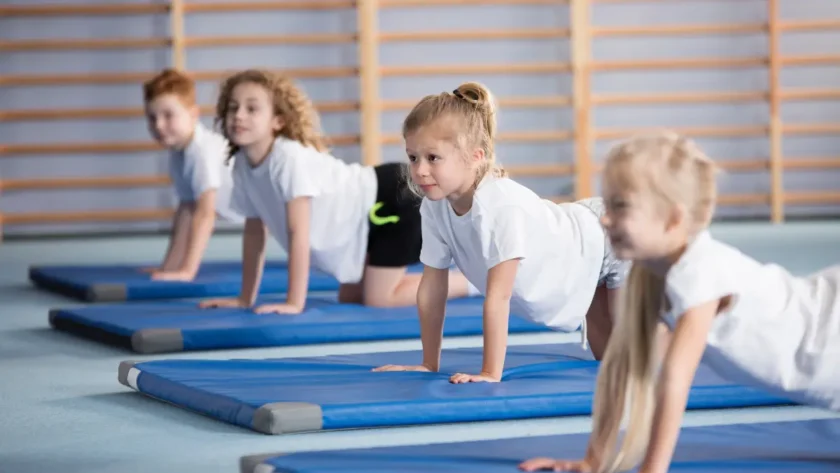Gymnastics offers a variety of paths for athletes, whether they are aspiring to compete at the highest levels or seeking a more flexible, fun approach to the sport.
The two main competitive tracks available through USA Gymnastics (USAG) are the Junior Olympic (JO) Program and the Xcel Program. Each provides unique opportunities, allowing gymnasts to choose the path that best aligns with their goals and commitment levels.
Contents
Junior Olympic Program
The Junior Olympic (JO) Program is the most widely recognized and structured gymnastics competition pathway in the United States, governed by USA Gymnastics.
This program is designed for gymnasts who aim to compete at high levels and eventually progress to elite gymnastics, including the possibility of competing in collegiate or international competitions.
The JO Program consists of ten levels, ranging from Level 1 (beginner) to Level 10 (elite), and it provides a comprehensive structure for training, competition, and progression.
Structure of the Junior Olympic Program
The Junior Olympic Program is divided into three primary phases: developmental levels (1-2), compulsory levels (3-5), and optional levels (6-10). The program is progressive, meaning that gymnasts advance through each level based on their skill development, ability to meet specific performance criteria, and competition scores.
1. Levels 1 and 2 (Developmental Levels)
These levels focus on building the foundational skills needed for gymnastics. They are intended to help athletes develop basic gymnastics abilities, such as flexibility, strength, and coordination.
- Level 1: At this stage, gymnasts work on basic skills like forward rolls, handstands, and simple vaults. There are no competitive requirements for Level 1.
- Level 2: Gymnasts continue to refine their basic skills while starting to learn more complex movements. This level may introduce competitive routines, but they are still simple and focus primarily on form.
2. Levels 3 to 5 (Compulsory Levels)
These levels require gymnasts to perform compulsory routines, meaning that every gymnast in these levels performs the same skills and routines on each apparatus. The focus is on consistency, form, and technique.
- Level 3: Gymnasts begin to perform more advanced elements on all four apparatuses (vault, uneven bars, balance beam, and floor exercise). For example, Level 3 may require skills like a back handspring on floor and a front handspring vault.
- Level 4: The routines become more difficult, with gymnasts incorporating more advanced skills such as front handsprings, roundoffs, and simple tumbling passes on the floor.
- Level 5: Gymnasts must demonstrate strong execution of more complex skills like back handsprings, back tucks, and front handspring vaults. The routines are designed to test the gymnast’s ability to perform consistently and precisely.
3. Levels 6 to 10 (Optional Levels)
Starting at Level 6, gymnasts can perform optional routines, meaning they can create their routines based on a set of required skills. The level of creativity and difficulty increases, with gymnasts allowed to incorporate advanced elements and sequences.
- Level 6: This is the first level in the optional routine progression, and gymnasts are expected to demonstrate proficiency in more difficult skills such as handsprings and layouts. Gymnasts begin to show more artistry in their floor routines and gain more control over their routines.
- Levels 7-10: The difficulty continues to escalate, with gymnasts performing highly advanced skills. For example, at Level 7, gymnasts may begin to incorporate double back handsprings or full twisting vaults. At Level 10, gymnasts are performing some of the most challenging skills in the sport, such as double layouts, full-twisting vaults, and advanced release moves on the bars.
Skill Progression and Training
The Junior Olympic Program focuses on a progressive training system, where gymnasts develop foundational skills in the early levels and then gradually advance to more difficult skills as they progress. At each level, gymnasts are required to demonstrate proficiency in a set of skills before advancing to the next level.
Training intensifies as gymnasts move through the levels. While gymnasts at the lower levels may train for 6-10 hours per week, those in higher levels (Levels 6-10) can train between 20 and 30 hours per week, particularly as they prepare for competition at regional and national meets.
Training Focus:
- Levels 1-2: Focus on strength, flexibility, and coordination. Emphasis on developing body awareness and basic gymnastics elements.
- Levels 3-5: Focus on building mastery over basic skills and precision in the compulsory routines. Gymnasts work on developing form and execution to meet specific scoring criteria.
- Levels 6-10: Advanced training focusing on mastering complex skills and routines. Gymnasts develop strength, flexibility, and endurance to execute high-difficulty moves. Routine composition becomes an important aspect as gymnasts perform customized routines based on their strengths.
Competition Structure
The JO Program follows a structured competition format that begins at the local level and advances to state, regional, and national competitions. The program includes compulsory meets for Levels 3-5, where gymnasts must perform the same routine across all competitions. From Level 6 onward, gymnasts compete in optional meets, where they perform their own routines.
- Local Meets: Gymnasts begin by competing in small, local competitions, gaining experience and developing their competitive mindset.
- State Meets: Gymnasts who perform well at local meets can advance to state-level competitions. These meets are often more competitive and serve as the qualifying platform for regional events.
- Regional Meets: Regional competitions are broader events that involve gymnasts from several states within a particular geographic region. The top performers can qualify for the National Championships.
- National Championships: The USA Gymnastics National Championships are the pinnacle of the Junior Olympic Program, where the best gymnasts in the country compete for titles in their respective age groups and levels.
The Xcel Program
The Xcel Program is an alternative competitive gymnastics program offered by USA Gymnastics, designed for gymnasts who want a less intensive, more flexible route to competition compared to the traditional Junior Olympic (JO) Development Program.
Introduced in 2010, the Xcel Program provides an opportunity for gymnasts to compete while balancing their athletic pursuits with other life commitments, such as school activities, family obligations, or other sports.
This program is designed for gymnasts who may not want to commit to the rigorous training schedules required by the JO Program but still wish to enjoy competitive gymnastics.
Structure of the Xcel Program
The Xcel Program is divided into five levels: Bronze, Silver, Gold, Platinum, and Diamond. These levels provide a range of competition opportunities, from beginner to advanced levels, with progressively more difficult skills and routines.
- Bronze: Entry-level with basic skill requirements.
- Silver: Slightly more advanced skills than Bronze.
- Gold: Intermediate level with increased skill complexity.
- Platinum: Advanced skills, comparable to JO Levels 6-7.
- Diamond: Highest Xcel level, similar to JO Level 8.
At each level, gymnasts can select the skills they wish to perform, provided they meet certain criteria for difficulty and execution.
Training Commitment
Compared to the Junior Olympic Program, which typically requires gymnasts to train between 20-30 hours per week at higher levels, the Xcel Program is designed to offer more flexibility in terms of training time. While gymnasts at the higher Xcel levels (Gold, Platinum, and Diamond) may train more hours than those at Bronze and Silver, the overall commitment is still lower than that of the JO Program.
- Bronze and Silver levels: These gymnasts may train around 6 to 10 hours per week.
- Gold, Platinum, and Diamond levels: Gymnasts at these levels typically train around 12 to 20 hours per week, depending on their age, goals, and commitment level.
This flexible training schedule makes the Xcel Program an appealing option for athletes who may have other commitments, such as school or part-time jobs, and want to enjoy competitive gymnastics without the heavy time commitment required in the JO Program.
Competition Structure
The Xcel Program provides competitive opportunities similar to those in the Junior Olympic Program but with more flexibility and a less rigid structure. Gymnasts can progress through the levels based on their performance in competitions and may compete at various local, state, regional, and national levels.
- Local Meets: Gymnasts begin by competing in local competitions, which can vary in size but are typically organized within their gyms or clubs.
- State Competitions: Gymnasts who perform well at the local level can qualify for state-level competitions. These events are more competitive and provide an opportunity for gymnasts to demonstrate their skills on a larger stage.
- Regional and National Competitions: At the higher levels, gymnasts have the opportunity to compete at regional and national meets, where the top athletes from across the country gather to showcase their skills. Gymnasts who perform well at national events may earn recognition and scholarships for collegiate gymnastics programs.
Junior Olympic Program vs Xcel Program: Key Differences in Scoring
The Junior Olympic (JO) Program and the Xcel Program are two distinct competitive pathways in U.S. gymnastics, each with its own approach to scoring and evaluation.
1. Composition Deductions
Junior Olympic (JO) Program:
Composition Deductions are applied at Levels 8 and higher. These deductions are taken if a gymnast’s routine is missing required elements, such as specific skill categories or skill combinations.
For example, a gymnast may be penalized if their floor routine doesn’t include a balance element or if they fail to demonstrate the required tumbling passes.
Reason: The JO Program emphasizes fulfilling specific composition requirements, ensuring that routines are well-rounded and meet the established criteria for higher levels of competition.
Xcel Program:
The Xcel Program does not have composition deductions. Gymnasts are not penalized for missing specific required elements or for routine composition errors.
Reason: The Xcel Program is designed to allow gymnasts more freedom and creativity in their routines, which means they are not penalized for missing particular skill elements that are part of a prescribed routine. This allows gymnasts to select the skills that best match their abilities and strengths without worrying about meeting a strict composition checklist.
2. Difficulty and Bonus Points
Junior Olympic (JO) Program:
The JO Program includes a bonus point system. Gymnasts earn extra points for performing difficult skill combinations or higher-level skills. This rewards gymnasts for pushing the difficulty of their routines and performing harder elements.
Reason: The goal of the JO Program is to push gymnasts to perform at the highest level, so difficulty is directly rewarded in the scoring system. Gymnasts who successfully execute challenging elements can accumulate additional points, contributing to their overall score.
Xcel Program:
The Xcel Program does not have a bonus point system. Gymnasts are scored based on the execution and artistry of the skills they perform, with no additional points awarded for difficulty.
Reason: The Xcel Program is intended to be less focused on difficulty and more on the gymnast’s ability to execute skills well while showcasing artistry. This removes the pressure to perform complex elements and focuses on precision and form.
3. Artistry and Presentation
Junior Olympic (JO) Program:
Artistry is important but less emphasized. While there is an emphasis on presentation and the overall flow of a gymnast’s routine, the primary focus is on technical execution and meeting the skill requirements.
Reason: At higher levels (Levels 8-10), artistry becomes increasingly important, but it is still considered secondary to the technical difficulty and accuracy of the routine.
Xcel Program:
Artistry and presentation are highly emphasized. The Xcel Program places a significant focus on the gymnast’s choreography, expression, and overall performance quality.
Gymnasts are encouraged to express their style, and artistry is a core element of how the routine is judged. A gymnast’s ability to engage with the audience and perform with fluidity and grace is an important factor in their score.
Reason: The Xcel Program offers gymnasts more freedom to personalize their routines, so showcasing unique style and artistic expression is an integral part of scoring.
| Feature | Junior Olympic Program | Xcel Program |
|---|---|---|
| Composition Deductions | Applied at Levels 8 and above for missing required elements | No composition deductions; routines are flexible |
| Bonus Points for Difficulty | Yes, gymnasts earn bonus points for difficult skills and combinations | No bonus points; score based solely on execution |
| Artistry and Presentation | Artistry is considered but is secondary to technical execution | Artistry and presentation are highly emphasized, allowing for creativity and personal style |
In conclusion, both the Junior Olympic and Xcel Programs offer valuable experiences in competitive gymnastics. The right choice depends on your gymnast’s goals, commitment level, and personal preferences. Consulting with a knowledgeable coach can provide personalized guidance to help make the best decision.




